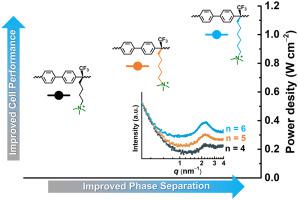Journal of Power Sources ( IF 8.1 ) Pub Date : 2022-12-30 , DOI: 10.1016/j.jpowsour.2022.232590 Tao Wang , Yu Zhao , Sheng Wang , Sheng Cheng , Shanzhong Yang , Haibing Wei , Yunsheng Ding

|
A major challenge in anion exchange membrane (AEM) fuel cells is the development of high-performed AEMs that can simultaneously meet the criteria of alkaline stable, swelling resistant, and ion conductive. Pentyltrimethylammonium-tethered poly(arylene alkylene)s are emerging as one of the most promising candidates in AEM community, however, they also suffer from conductivity−water uptake trade-offs and improvement-needed alkaline stability. Herein, a series of poly(biphenylene alkylene)-based membranes, PBPA-n-QAs (n = 4, 5, 6), with different alkylene spacer length are synthesized by hydroxyalkylation polymerization and the subsequent amination. The membranes are found to have an improved phase separation as the number of carbon atoms of the alkylene spacers increased from 4 to 6. The ordered morphology and continuous hydrophilic channels make the PBPA-6-QA membrane with outstanding properties including suppressed water uptake, high ion conductivity, and improved alkaline stability. Specifically, the PBPA-6-QA membrane yields the highest hydroxide conductivity (180 mS cm−1 at 80 °C), which is considerably higher than that of PBPA-5-QA and PBPA-4-QA. Furthermore, a single cell using PBPA-6-QA shows a peak power density of 0.97 W cm−2 and can operates stably at a constant current density of 0.2 A cm−2 for 90 h without membrane degradation.
中文翻译:

通过调节季铵化聚(亚联苯基亚烷基)的主链-阳离子亚烷基间隔基,实现阴离子交换膜的高碱稳定性和燃料电池性能
阴离子交换膜 (AEM) 燃料电池的一个主要挑战是开发高性能 AEM,同时满足碱稳定、抗溶胀和离子导电的标准。戊基三甲基铵系链聚(亚芳基亚烷基)正在成为 AEM 社区中最有前途的候选者之一,但是,它们也存在电导率-吸水率权衡和需要改进的碱性稳定性等问题。在此,一系列基于聚(亚联苯基亚烷基)的膜,PBPA- n -QAs ( n = 4, 5, 6), 具有不同的亚烷基间隔长度,通过羟烷基化聚合和随后的胺化合成。随着亚烷基间隔物的碳原子数从 4 增加到 6,发现膜具有改进的相分离。有序的形态和连续的亲水通道使 PBPA-6-QA 膜具有突出的性能,包括抑制吸水,高离子电导率,提高碱稳定性。具体而言,PBPA-6-QA 膜产生最高的氢氧化物电导率(80 °C 时为 180 mS cm -1 ),远高于 PBPA-5-QA 和 PBPA-4-QA。此外,使用 PBPA-6-QA 的单电池显示出 0.97 W cm -2的峰值功率密度并且可以在0.2 A cm -2的恒定电流密度下稳定运行90 h而不发生膜降解。





















































 京公网安备 11010802027423号
京公网安备 11010802027423号